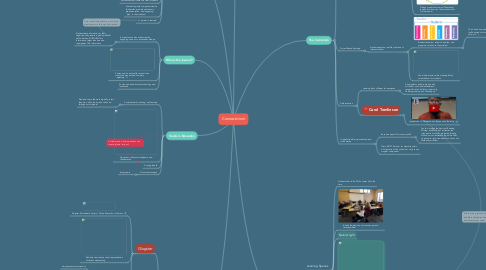
1. Who is the learner?
1.1. A digital native who seeks creative, engaging options to acquire knowledge
1.1.1. Students have information at their fingertips--they require a guide who will walk with them THROUGH this information, rather than one who regurgitates THE information
1.2. Someone who works with content in an innovative way instead of merely "digesting" it
1.3. Someone who embraces technology and innovation
2. Who is the teacher?
2.1. Someone who strives to engage students through meaningful instruction and assessment
2.2. Someone who aims to teach students all that they can, not what is "enough"
2.3. Someone who embeds themselves within the microcosm of their classroom, not plants themselves at the front of it
2.4. Someone who "strokes creativity" instead of "teaching facts"
2.5. Someone who is interactive and customizes their content for their students
2.6. A technologically competent creative thinker who promotes autonomy, experimentation, and engaging "play" in the classroom
2.7. A "partner in learning"
3. Trends in Education
3.1. Social networks, sharing, and learning
3.1.1. Students can collaborate digitally; in fact, they do it all of the time on their own through social media!
3.2. Openness, collective intelligence and collaboration
3.3. Acting globally
3.4. Visual data/analysis
3.4.1. Infographics
4. Sample Assignment Options
4.1. Glogster
4.1.1. Glogster: Multimedia Posters | Online Educational Content
4.1.2. Students can create a visual representation of their understanding
4.1.3. Allows for differentiation in so many different ways
4.1.3.1. Ample assessment options
4.1.3.2. Work individually or in groups
4.1.3.3. Can be assessment OF or FOR learning
4.1.3.4. Uses multiple levels of Bloom's taxonomy
4.1.3.5. Allows for different learning styles to be used
4.2. Alice
4.2.1. Create a digital world
4.2.2. Learn to program
4.2.3. Alice – Tell Stories. Build Games. Learn to Program.
4.2.4. Allows for differentiation
4.2.4.1. Work individually or in small groups
4.2.4.2. Create a world (perhaps Shakespeare's Globe Theatre or the world of Scout's Maycomb county in To Kill a Mockingbird!)
4.2.4.2.1. Alice Animation Example: Dinosaur
4.2.5. Allows for 21st century skills
4.3. Peer Evaluation
4.3.1. Collaboration is imperative to connectivism
4.3.2. Create individually o in a group
4.3.2.1. Provide positive and constructive critique
4.3.2.1.1. Can always film assignments and/or the feedback
5. Definition
5.1. A learning theory for the digital age
5.2. Stresses the significance of connection
5.3. Requires diversity of opinions and the acquisition of new truth and knowledge (not just what we already know/history)
5.4. Education is a life-long commitment; we are all life-long learners
5.5. Learning involves a network of connections
6. The Classroom
6.1. Learning Spaces
6.1.1. Students should be AT the center all of the time
6.1.2. Ideally, learning can occur at any point in time anywhere
6.1.3. Natural light
6.1.4. Ample collaborative writing space
6.1.5. Virtual space to work (digital)
6.1.6. Flexible
6.2. Ubiquitous learning
6.2.1. Learners can learn anything anywhere
6.2.1.1. 9. Ubiquitous learning | CORE Education
7. The Curriculum
7.1. Inquiry Based Learning
7.1.1. Learners are put at the center of their learning. Students drive their own learning
7.1.1.1. KWHL method (what do I know, what do I want to know, how will I learn it, and what have I learned)
7.1.1.2. Design product outcomes (What have I learned and how can I demonstrate that I've learned it)
7.2. Project Based Learning
7.2.1. Students examine real-life problems of interest to them
7.2.1.1. Students examine, research, analyze, and prepare a solution to the problem
7.2.1.1.1. This does bring about a host of challenges (self-directed curriculum, pacing, classroom time, etc...)
7.2.1.2. Learning becomes more meaningful and career-based for students
7.3. Differentiation
7.3.1. Learning looks different for eeveryone
7.3.1.1. Key elements include: high-quality curriculum, continual assessment, respectful tasks, building community, flexible grouping, and teaching up
7.3.2. Carol Tomlinson
7.3.2.1. Introduction to Differentiation: Responsive Teaching
7.4. Is ideally flexible, personalized, and collaborative
7.4.1. Revolves around 21st century skills
7.4.1.1. Yes this involves the basics of Reading, Writing, and Math, but it stresses the importance of critical, evaluative thinking around our current technological world as opposed to rigid, traditionalist notions of a textbook curriculum
7.4.2. There MUST be room for creativity within ALL subjects of the curriculum, not just one singular component
